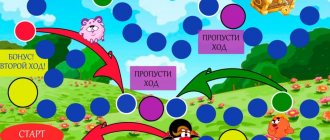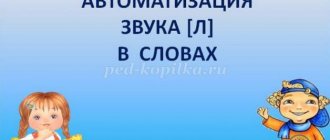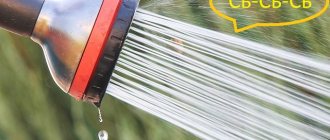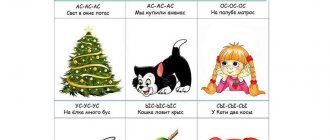Homework for the sound L for parents is developed comprehensively and contains numerous games and exercises. You can download these lessons from our website in one file (see below).
These are 20 lessons with various tasks:
- articulatory gymnastics for the sound “L”;
- automation in syllables, words, phrases, sentences, texts, poems;
- retelling and composing stories based on mnemonics and plot pictures;
- learning funny poems;
- repetition and memorization of pure phrases;
- interesting tasks on adventure games, coloring books, games and exercises based on our website logoped-online.by
Each lesson is located on 2 sheets of A4 format. You can print on two sheets, or on one - a page on each side. Total, 20 sheets - 20 full-fledged lessons for practicing the sound “L”.
The classes are developed based on our website logoped-online.by . On the site you will find colorful illustrations, mnemonic tracks, games and exercises to help with the printouts.
Instructions included.
Each lesson contains a set of articulation exercises for the sound “L”. At the beginning, all exercises are presented in pictures and with descriptions. Further descriptions are attached only to new exercises. Articulatory gymnastics exercises are necessary to prepare the speech apparatus, so do them. And your baby will speak faster!
In each lesson you will also find a lot of varied speech material . Pictures of the speech material can be found using the provided links or QR codes. You can log in from your smartphone using a special application. By following links or codes you get to the site and complete the same tasks, but with the help of pictures. All this is done in order to make classes as interesting and comfortable as possible for kids.
In order for the child to find it both interesting and at the same time useful, the classes are supplemented with numerous coloring pages . This is both visibility for the child and the development of fine motor skills of the fingers. Let us remind you that it is better to color with triangular pencils: they fit better in the child’s fingers.
And the main rule is to make sure that the child says the sound “L” correctly!!!
The website presents an abbreviated version of a set of lessons on strengthening the sound “L”. You can get the full version by writing to the email address
Automation of the L sound at the end of words:
- glass, pencil case, jackal, barbecue, dagger, ox, stake, table;
- goal, football, shot, basketball, chair, hall, grin, pedestal.
You can reinforce the sound L by naming or repeating words in pictures, or you can make classes even more interesting and varied. To do this, we offer you options for games and exercises. These games will help not only automate the sound in words, but also develop the grammatical structure of speech, memory, attention, and thinking of your baby.
Automation of isolated sound [L]
First, the articulation of a phoneme needs to be worked out in isolation, that is, separately from other phonemes. At the staging stage and during consolidation, it is important to use auxiliary processes - vision, touch. Based on visual stimuli that the preschooler rarely used or did not use at all, correct visual-motor and auditory-verbal stereotypes are created. The lesson should be conducted in front of a mirror so that the child can see his own face and the face of the teacher to control the correct articulation.
The sound needs to be fixed separately in an interesting playful way. Simply pronouncing a phoneme is not enough for a child to reproduce it correctly - in certain situations, a detailed explanation is required of how to position the organs of the speech apparatus in order to achieve accurate articulation. There are times when using analogies or imitating the actions of the tongue with the palm of your hand is effective. For a long time, it is important to remind the child visually and verbally how to pronounce [L]. When a sound is isolated, familiarization occurs with the letter denoting it.
Good Zlata
Zlata was sitting on a bench and eating a bun with sausage. A stray dog approached Zlata. She looked at the sausage, then at Zlata and whined quietly. It was clear from the dog's eyes that she had not eaten for a long time.
Zlata broke off half of the bun and gave it to the hungry dog. She ate everything instantly. Then the dog reached out to Zlata and began to affectionately lick her palms.
Elk and woodpecker
The elk stood under the tree and looked at the Woodpecker. The woodpecker grabbed the trunk of the tree with its tenacious paws and deftly sat on its tail. He hollowed out the trunk and pecked out larvae and beetles from it.
“How are you, Woodpecker?” - exclaimed Elk standing under the tree. “Things are bad! - Woodpecker answered. - Jackdaw let me down. She promised not to occupy my hollow, but she did. She raised chicks in it. I was left without a home!
Elk, without thinking twice, said to Woodpecker: “Listen, gore Jackdaw.” And he started laughing. The Woodpecker understood the elk's cruel joke. After thinking, Woodpecker replied: “Not a bad idea! Just you, dear Elk, climb up my tree - together we’ll fly to Jackdaw!”
How little Zlata became big
Little Ella really wanted to become big. She did everything for this! She put on my mother's high-heeled shoes. She curled her hair. She put beads around her neck. She even let her lips down with lipstick. But everyone in the house still called Ella baby.
One day Ella herself washed all the dishes in the kitchen and swept the floor. And then I made an omelette! And then suddenly dad said to mom: “Our Ella has become very big!”
Apparently, it’s not heels and lipstick that make people big!
Unusual peg
Pavel planted a small apple tree in the garden. The trunk of the apple tree was thin - just like that, it would break. Pavel made a stake and stuck it in the ground near the apple tree. Pavel connected the weak trunk of the apple tree and the peg with a bandage. I tied up the apple tree and calmed down. All that was left was to wait for the green leaves.
Every day Pavel went to the apple tree and watered it. I watched the branches carefully. But there were still no green leaves!
One day Pavel saw from the window that his apple tree had finally turned green. When Pavel came closer, it turned out that it was on the peg, and not on the apple tree, that several green leaves appeared! “That’s a peg!” - Pavel thought.
Automation [L] in connected speech
Fixing a phoneme in coherent speech is the most important stage of automation. At this stage, work with the phoneme in specially organized situations is completed. Next, the phoneme will be used in your own spontaneous utterances.
Not all children need to practice pronunciation using text material - if a child easily uses the given sound without difficulty, it is advisable to start spontaneous speech. But most children definitely need reinforcement in the text. For work, short stories are chosen, enriched with the phoneme being practiced.
When working with texts, sound is used without lengthening, without exaggerated articulation. The phoneme must be equivalent in relation to the flow of other phonemes. At this stage, stories of different types are used:
- Stories based on reference pictures are a transitional step from repeating phrases to retelling texts. Stories should be short, [L] should be contained in only a few words, which are proposed to be inserted in the right place after showing the image.
- Stories-tasks. The work begins in a similar way with one or two words. The speech therapist reads the problem, the child must solve it and answer orally in one word, and then in an expanded phrase.
- Stories on leading questions.
- Ordinary stories with a lot of fixed phoneme. Questions are also allowed here.
- Writing a story on a specific topic. The child is given a topic for an essay and words with a fixed phoneme, which he must include in his story. These classes prepare you for incorporating phonemes into your own speech.
Automation [L] in words
You should not fix the phoneme in syllables for too long; you should start working on words as quickly as possible. This is important because in words the sound is surrounded by other sounds that leave a characteristic auditory-speech imprint. Also, children perceive meaningful, meaningful words more easily.
In addition to the meaning accessible to the child, words for automation work play a very significant role. They help fix the phoneme in different positions and create the necessary articulatory patterns. The child does not memorize all the words of his native language with the studied phoneme, he learns to pronounce various combinations with the new phoneme, which will later be used in other words containing the phoneme [L].
Automation of [L] in words is carried out according to the following algorithm:
- Practicing words starting with [L].
- Practicing the intervocalic position [L] (between two vowels).
- Practicing words ending in [L].
- Practicing [L] in the middle of a word.
- Consolidation in words containing several sounds [L].
striped stick
Vladik walked with Polkan and constantly threw a stick at him. Polkan did not want to carry a stick. Then Vladik himself began to run after the stick. He knelt down, picked up a stick from the ground with his teeth and carried it to Polkan. Yes, studying was hard!
Once Vladik threw the stick especially far. Polkan was not seen for a long time. Finally, Vladik noticed that Polkan was carrying a stick in his teeth. The owner smiled contentedly. When Polkan came closer, Vlad saw in his mouth... a striped police baton!
Bad thing
A small kitten was sitting on the steps at the entrance. Near him, with his head down, stood a large dog - a Dalmatian. The dog barked angrily at the kitten.
Not far away, on a bench, sat Vlad, the dog’s owner. He looked at his dog and smiled. The little kitten cowered and squeaked.
An elderly woman came out of the entrance. She picked up the kitten and commanded the dog: “Ugh! It is forbidden! Go away!" Then the woman came up to Vlad and said: “I found myself some fun! And aren’t you ashamed?” Vlad replied: “What? I did not do anything!" “That’s what’s bad!” - the woman remarked.
Automation [L] in poems
When a child learns to accurately pronounce sound in words, phrases and sentences rich in it, you can begin to reinforce it in poems.
For classes, it is advisable to select works that do not contain oppositional sounds [L] and [P] or those with which [L] was replaced before production.
You should try to choose poems with a meaning that is accessible to the child, based on his age characteristics and level of general development. If there are unknown or incomprehensible words, you need to carry out dictionary work, during which their meaning is explained. Understanding the meaning helps when speaking the text.
If a poem provokes the emergence of negative emotions or associations, you should not insist on working with it.
There is no need to offer long poems to a small child - it is difficult for a child to retain a large plot, he will lose the thread of meaning and reproduce a set of words. You cannot use poems with too long lines or a complex word order - this also complicates the understanding of the meaning and worsens the quality of speech.
The poem is offered one line at a time, and the child is asked to repeat. This process is called reflected recitation. Joint simultaneous pronunciation (conjugate) is not allowed at this stage. If a preschooler has difficulty remembering and reproducing the entire line at once - he cannot remember, confuses the order of words, or incorrectly says the sound being reinforced in one or more words - he needs to switch to repeating one word at a time. When introducing a child to a text, you should use your voice to highlight the phoneme being studied.
Words are pronounced in accordance with orthoepic rather than spelling rules. The same verse must be practiced over several lessons. Poems previously known to the child, but with a broken phoneme, are relearned after going through all stages of automation.
It's a pity!
It was summer. Volodya’s mother left home on business. She left her son some money and told him to go to the store. Volodya had to buy two packages of milk, two packs of butter and a package of sour cream.
Volodya took his bag and went to the store. He bought butter, sour cream and milk. When Volodya entered the entrance, the boys he knew called out to him: “Volodya, come out, let’s play football!”
Volodya flew into the kitchen, threw his bag on the floor and immediately ran out into the street. After half an hour in a warm place, without a refrigerator, the milk turned sour, the butter began to flow, and the sour cream became liquid and tasteless.
What a pity!
Automation [L] in a phrase
Automation of the sound [L] in sentences represents a transitional link between the artificial pronunciation of individual words and independent speech. The child needs to control the correctness of the pronounced sound, as well as convey the essence of the statement. In addition, to pronounce a phrase consisting of several words, a long, even exhalation is required.
To move on to pronouncing phrases, it is necessary to speak the phoneme quite freely, and not use syllable-by-syllable pronunciation. The speech organs must quickly adapt from one articulatory position to another. It is advisable to use pure tongue twisters and tongue twisters. It is extremely undesirable at this stage to incorrectly pronounce the sound being studied.
It is necessary to cultivate a calm, smooth pace of speech. If a child speaks quickly and pronounces sounds vaguely, he will not get used to controlling the correctness of his own speech. Such a child can deform or skip even those phonemes that he speaks correctly in isolation. Developing a measured speed provokes an improvement in sound pronunciation. Speech volume is also important.
Fun party
The last day of the year has arrived. Lyudmila was waiting for guests for dinner. How many things does a young housewife need to do?
First, she ran to the store, then washed all the dishes. Lyudmila installed a Christmas tree in the corner of the room and hung light bulbs on it.
“Just to make it in time for dinner!” - flashed through her head. Lyudmila baked a turkey in the oven, made several salads, and then put sweets and apples in a vase. All that remained was to put on a new dress.
The tired housewife lay down on the sofa for a minute... Lyudmila did not hear the calls.
When the New Year arrived, she slept soundly!
Blue scarf
Mila bought a blue scarf. It was smooth, silky, with tassels - a sight to behold! —
Mila wanted to wear a headscarf to school. When Mila took the scarf from the shelf, it turned out to be wrinkled. Mila began to iron the scarf. But then, as luck would have it, the phone rang in the kitchen. Mila ran out of the room and left the iron on the scarf...
When Mila entered the room, she realized that her blue scarf was gone!
Tasks and exercises for sound automation [l]
A selection of tasks and exercises for sound automation [l]
Letters in disguise
The letter L loves to dress up in different clothes. She can be difficult to recognize. Let's try to recognize her in different outfits. Name all the letters L and underline them.
Find the letter in the picture
The letter L decided to play hide and seek with you. Find all the letters L in the pictures, point them out with your finger and name them.
Balabolki
The letter L wants to tell you about his chatterbox girlfriends. They chatter all the time. In order to talk to them, try to remember their language.
LA-LA-LO LY-LE-LA LE-LY-LE LA-LY-LO LY-LY-LA LOLY-LA LU-LY-LE LU-LO-LA
Room L
This is L's room. Find objects in the room whose names contain the sound L. Name all these objects, and then color them.
Mysteries of the sound L
In front of you
is rack
L. First, name what is on the top shelf, then - on the bottom and finally - on the rest. And now L will ask you questions. Try to answer them correctly.
What's between an apple and an onion? What is to the left of the doll and above the apple? What is under the onion and to the right of the spoon? What is between the spatula and the hammer? What is under the top and above the fork?
Game "Say the other way around"
L wants to play the game “Say it backwards” with you.
L will name you pictures and tell you what they are, and you will have to say the opposite.
For example:
milk can be hot and it can be cold.
A wizard can be good, but sometimes... (evil). The wolf can be well-fed, but sometimes... (hungry). The horse can be black, but it can also be... (white). The glass can be empty, but it can be... (full). Hair can be dark, but it can also be... (light). A person is sometimes elderly, and sometimes... (young).
Carriages
Friends were visiting L.
The time has come to see them off; they arrived at the station
and forgot who was in which carriage. Help them sit in their seats. Guests with the sound L at the beginning of the word are placed in the first carriage, with the sound L in the middle of the word - in the middle carriage, with the sound L at the end of the word - in the last carriage. Draw an arrow from the passenger to the trailer in which he will ride.
Camping in the woods
L with friends in the forest. Look carefully at the left picture and name everything with the sound L. Now look at the right picture and say: what did the children take with them and what did they forget in the forest?
Automation of the L sound in words
Letter
Together with L, write a letter to her grandmother. Pictures will help you with this. I'll start the sentence, and you finish it.
The witch at the ball... what is she doing?
The crybaby is in the room...what's she doing? A raft on the water...? Does Mila have a heel...? Baby by gender...? Clown slyly...? Chatterbox on the bench...? At the ball, who casts a spell? Crying in the room...? Floating on the water...? Mila's broke...? Crawling on the floor...? Smiling slyly...? Chatting on the bench...? Choose a picture
Name all the pictures in the boxes. Find a suitable picture, name it and place it in an empty window (draw an arrow from the picture to the window). Explain why you did this.
Halves
An evil wizard stole the halves of pictures with the sound L. Tell me, the halves of which objects were stolen by the wizard?
For example: half a moon, half an apple.
Now finish drawing the objects so that they become whole.
L has a wizard friend. Today he didn’t get enough sleep and wrote a letter in which he mixed everything up. Help the wizard correct mistakes in the letter, and then find a suitable picture.
Wizard
- There is a sky on the moon.
- Mom made beets from the salad.
- Refrigerator in sausage.
- The head is on the scarf.
- Kalach ate Slava.
- The apple squeezed the juice out of Mila.
- Waves float on the boat.
Mila visiting
(chain text) Mila went to visit the
village.
Listen to the story about this and, based on the pictures, try to retell it.
Mila went to the village to visit Aunt Klava.
Aunt Klava had a horse. Mila was riding a horse. Aunt Klava bought a comfortable saddle for Mila.
Lazy Pavel
(retelling based on a series of pictures) The sound L has a familiar boy, Pavel.
He's lazy. Likes to sit idle.
Listen to the story about him and try to remember.
Pavel went outside and sat down on a bench.
I sat on the bench and looked at the sun. It baked his head. Pavel went home. Sat on a chair. I sat and looked at the ceiling. He sat on a chair, got up and sat on a rocking horse. I sat on the rocking chair and looked at the floor. He got up from the rocking chair, walked around, walked around and sat down on the floor. He fell asleep on the floor. So Pavel wasted his time all day.
Kitten Naughty
(retelling based on a series of pictures) L visited his girlfriend Lada and drew pictures about it. Now he wants to tell you about his friends: Lada and her kitten. Try to remember this story. Be careful! L mixed up all the pictures. Please number them correctly and retell L's story.
Lada had a cute kitten. He was white-footed, white-fronted, white-tailed and very playful. Lada stroked the kitten and gave him milk from a blue bowl. When Lada sat down to learn the letter L, the kitten was naughty. He rolled knitting balls on the floor. Then the kitten got tired and went to sleep on a soft, warm bedding under the table.
Find, show and say the letter L
Exercise "Steamboat".
Look at the picture.
How does the ship sound? (L-l-l...)
Help the ship sail to the pier. Run your finger along the path, pronouncing clearly: L-L-L...
Exercise "Songs".
The squirrel decided to teach all the animals in the forest to correctly pronounce her favorite sound L. For this she came up with syllabic songs! Listen carefully and repeat the songs with Squirrel. Try not to make mistakes.
Exercise “Say the opposite.”
Listen to the suggestions. Add to each sentence a suitable word with the sound L. Repeat the entire sentences, emphasizing the sound L. A pair of pictures will help you cope with the task.
The birch tree has a thin trunk, and the oak tree has a ... (thick)
The hare is cowardly, and the lion is ...
(brave)
The soup is hot, and the popsicle is ...
(cold)
The dog is well-fed, and the wolf is ...
(hungry)
The balloon is light, and the weight is ...
(heavy)
The giant is strong, and Thumbelina is ...
(weak) )
Marfushka is rude, and Nastenka is ...
(affectionate)
Exercise "Find the word."
Name the pictures, highlighting the sound L. Find words in which the sound L is at the beginning (in the middle, at the end). Connect each picture with the corresponding diagram. Make up a sentence with each word - the name of the picture. Come up with your own examples of words for each diagram.
Exercise "Magic track".
Help the swallow fly to its nest. To do this, read the syllables and words on the magic path of clouds. Make up sentences with the words you read.
Exercise “Syllabic Lotto”.
Help Lada collect an unusual bouquet. Read the syllables written on the flowers and make words from them. The color of the petals will help you cope with the task. Together with Lada, make up sentences with the resulting words.









